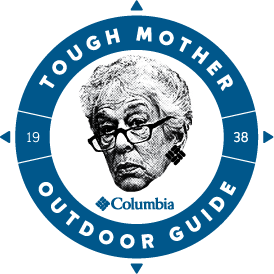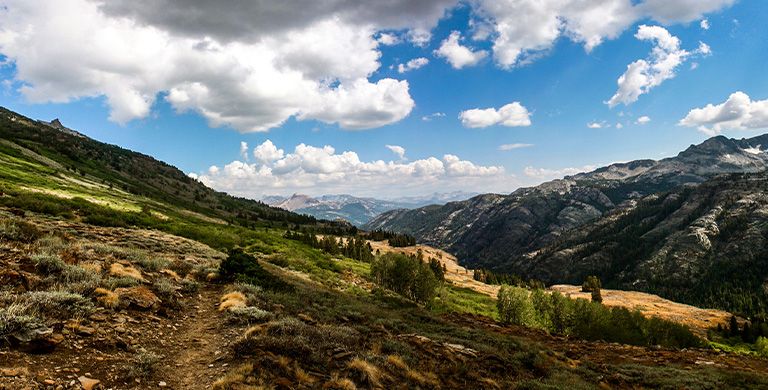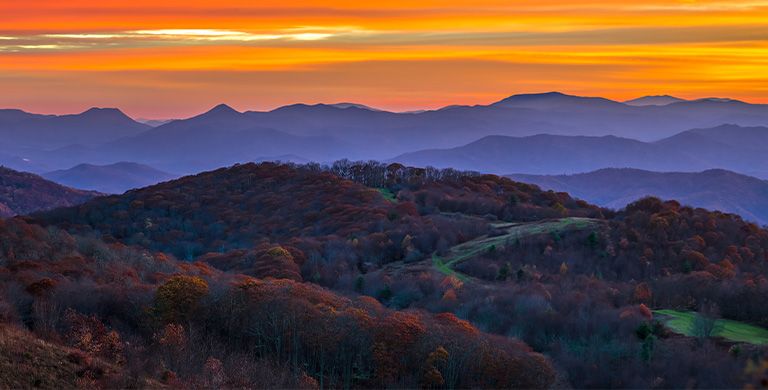
HIKING
Seeking A Summit: An Introduction to Peak Bagging
From backyard hills to Everest thrills: peak bagging is an adventure you might not have heard of, but one you'll want to start.
BY: NANCY BOUCHARD
You don’t need to be a mountaineer to summit a peak—just a goal, a good pair of shoes, and a plan.
Peak bagging is simply getting to the summit of something, from a list that has meaning for you. It can include local hills, state high points, or celebrated peaks worldwide. Once you climb it, you check it off. You create the list and set the timeframe—and just like the mountains themselves--your list always evolves.
Reaching a summit is fun. It’s all about great views, bragging rights, and a well-earned sense of accomplishment. Whether you’re ambling up the local butte or shelling out for an Everest permit, peak bagging is the same game—just with different stakes in distance, difficulty, and dollars. As Phil Powers, President of The Mountain Guides, puts it, “You need two initial ingredients: you need to want to do it and you need to be basically fit. Once those two variables are in place, it's time to choose an objective on which success is highly likely. Have fun.” Whether you're looking to start small or dreaming big, it’s about the goal, the gear, and getting to the top.
Peak bagging doesn’t have to include rock or ice climbing, or snow slogging; it can be as simple and accessible as getting to the highest part of a hill on a beautiful day. In its simplest form, it only involves walking. At its most complex, when it’s called mountain climbing or alpinism, it can be more involved, requiring ropes, protective gear, and complex route finding. As Powers notes, “There is a mountain in our backyard in Vermont. It's six miles round trip and maybe 1,000 feet up. Start small, have fun, learn, and then step it up a bit.” Just remember that getting to high points requires walking up, and then down hill. That’s the challenge.
Some people think of peak bagging as working through elaborate lists of big-name mountains, but that list is yours to create. Every list starts with one summit. Your list, your rules. Sure, a small, over-the-top crowd takes it even further, chartering helicopters, hiring film crews, and flooding social media with selfies, but the deal is crafting your own list and checking off those goals with friends, family, or a local club. And, walking up a local peak is one of the most budget friendly activities you can pursue. How about the five highest natural points in your state that you can walk up? Or a peak in every national park? There are plenty of summits out there; it doesn’t have to be front-page news. In fact, you’ll probably enjoy it more if you do it just for yourself—and, as Powers recommends, have fun!
Peak bagging is simply getting to the summit of something, from a list that has meaning for you. It can include local hills, state high points, or celebrated peaks worldwide. Once you climb it, you check it off. You create the list and set the timeframe—and just like the mountains themselves--your list always evolves.
Reaching a summit is fun. It’s all about great views, bragging rights, and a well-earned sense of accomplishment. Whether you’re ambling up the local butte or shelling out for an Everest permit, peak bagging is the same game—just with different stakes in distance, difficulty, and dollars. As Phil Powers, President of The Mountain Guides, puts it, “You need two initial ingredients: you need to want to do it and you need to be basically fit. Once those two variables are in place, it's time to choose an objective on which success is highly likely. Have fun.” Whether you're looking to start small or dreaming big, it’s about the goal, the gear, and getting to the top.
Peak bagging doesn’t have to include rock or ice climbing, or snow slogging; it can be as simple and accessible as getting to the highest part of a hill on a beautiful day. In its simplest form, it only involves walking. At its most complex, when it’s called mountain climbing or alpinism, it can be more involved, requiring ropes, protective gear, and complex route finding. As Powers notes, “There is a mountain in our backyard in Vermont. It's six miles round trip and maybe 1,000 feet up. Start small, have fun, learn, and then step it up a bit.” Just remember that getting to high points requires walking up, and then down hill. That’s the challenge.
Some people think of peak bagging as working through elaborate lists of big-name mountains, but that list is yours to create. Every list starts with one summit. Your list, your rules. Sure, a small, over-the-top crowd takes it even further, chartering helicopters, hiring film crews, and flooding social media with selfies, but the deal is crafting your own list and checking off those goals with friends, family, or a local club. And, walking up a local peak is one of the most budget friendly activities you can pursue. How about the five highest natural points in your state that you can walk up? Or a peak in every national park? There are plenty of summits out there; it doesn’t have to be front-page news. In fact, you’ll probably enjoy it more if you do it just for yourself—and, as Powers recommends, have fun!

Digging into the history of peak bagging is a great way to start—it’s essentially the origin story of modern mountaineering. Back in the 18th and 19th centuries, European explorers weren’t checking off lists; they were obsessed with climbing anything that looked impressive. The U.S. got its first reasonably accurate topo map in 1879, thanks to the USGS, and ever since, hikers have been chasing summits, big and small. Plenty of peaks have solid trails to the top, and some—like Colorado’s 14,115-foot Pikes Peak or New Hampshire’s 6,288-foot Mt. Washington—are accessible by car--just in case you need a sag wagon.
Peak bagging needn’t be some epic quest or months-long saga—it’s just about reaching the top of something that calls to you. In my hometown of Bend, Oregon, we started our kids on Pilot Butte (a mellow two-mile round trip), then worked up to Tumalo Mountain--about twice the distance--and wrapped up the summer with day hikes up Mt. Bachelor, Black Butte, and South Sister. Now our daughters make their own lists—naturally, all requiring out-of-state travel. The best approach? Start local, start easy, and as your skills grow, so will your ambition.
If you’re looking for fun, accessible peaks, try Mount Monadnock in New Hampshire—with epic New England views. On the West Coast, Mount Tamalpais in California provides panoramic views of San Francisco and the Pacific. For a high point in the Midwest, Black Elk Peak in South Dakota has an easy trail leading to a historic stone lookout. And in Washington, Mount Pilchuck is a short but rewarding climb with a fire lookout at the summit.
Things to consider are vertical gain, trail length, altitude, weather, and the necessary skill set—there’s a big difference between “scrambling to the summit” and needing technical rock-climbing skills. Some peaks have trails that literally start at the parking lot. Others require a bit of backpacking to just reach the trailhead. Or pick a destination with a backcountry hut or full-service refuges—something the Alps and Italian Dolomites are famous for. That way, you combine an overnight stay or two—in style—with your peak-bagging adventure. It splits up walking distance, and most European-style alpine huts provide food, beverages and sleeping essentials.
Peak bagging needn’t be some epic quest or months-long saga—it’s just about reaching the top of something that calls to you. In my hometown of Bend, Oregon, we started our kids on Pilot Butte (a mellow two-mile round trip), then worked up to Tumalo Mountain--about twice the distance--and wrapped up the summer with day hikes up Mt. Bachelor, Black Butte, and South Sister. Now our daughters make their own lists—naturally, all requiring out-of-state travel. The best approach? Start local, start easy, and as your skills grow, so will your ambition.
If you’re looking for fun, accessible peaks, try Mount Monadnock in New Hampshire—with epic New England views. On the West Coast, Mount Tamalpais in California provides panoramic views of San Francisco and the Pacific. For a high point in the Midwest, Black Elk Peak in South Dakota has an easy trail leading to a historic stone lookout. And in Washington, Mount Pilchuck is a short but rewarding climb with a fire lookout at the summit.
Things to consider are vertical gain, trail length, altitude, weather, and the necessary skill set—there’s a big difference between “scrambling to the summit” and needing technical rock-climbing skills. Some peaks have trails that literally start at the parking lot. Others require a bit of backpacking to just reach the trailhead. Or pick a destination with a backcountry hut or full-service refuges—something the Alps and Italian Dolomites are famous for. That way, you combine an overnight stay or two—in style—with your peak-bagging adventure. It splits up walking distance, and most European-style alpine huts provide food, beverages and sleeping essentials.

Phil Powers explains that peak bagging adventures are now more attainable than ever. It’s a matter of picking an objective within your ability, making a plan, doing your homework—both training and preparation for the task—and accomplishing your goal, then building on it for your next objective. "These days, people can develop their stamina and pacing on non-technical peaks while simultaneously pushing their limits in the technical realm at the gym or local crag,” he says. That way, if you do have the chance for a bucket-list goal, like climbing Wyoming’s Grand Teton, one of Colorado’s famous 14ers, you’ll be in shape and have enough technical skills to make your guide proud. And don’t forget, peak bagging is great cross-training for many other activities like trail running, or thru hiking, or getting out with your four-legged friend.
No matter what you’re goal, it’s about pace and preparation. Powers shares an invaluable tip he learned at 19. “An old mountain climber, Paul Petzoldt, taught me something called the ‘rest step.’ He advised me to rest in the middle of each step completely, but briefly,” recounts Powers. “The rest step, which I still practice today, allows me to walk or climb with little effort. I can move very quickly yet still find a pause in every step. And whether you’re climbing a mountain or navigating daily life, this lesson is key to achieving any summit.”
In times of stress or challenge—both in summiting peaks and everyday life--pace becomes even more critical. As Petzoldt taught Powers, “When faced with an emergency, sit down, collect yourself, and make a plan. When needs seem most urgent—even life-threatening—the practice of slowing down offers calm and clarity.” This invaluable lesson helps guide you when the stakes are high—whether you're on a technical climb or simply pushing yourself to the limit. As Powers notes, “The mountains teach you more than just how to reach the summit—they show you how to move through life with purpose, patience, and clarity.”
No matter what you’re goal, it’s about pace and preparation. Powers shares an invaluable tip he learned at 19. “An old mountain climber, Paul Petzoldt, taught me something called the ‘rest step.’ He advised me to rest in the middle of each step completely, but briefly,” recounts Powers. “The rest step, which I still practice today, allows me to walk or climb with little effort. I can move very quickly yet still find a pause in every step. And whether you’re climbing a mountain or navigating daily life, this lesson is key to achieving any summit.”
In times of stress or challenge—both in summiting peaks and everyday life--pace becomes even more critical. As Petzoldt taught Powers, “When faced with an emergency, sit down, collect yourself, and make a plan. When needs seem most urgent—even life-threatening—the practice of slowing down offers calm and clarity.” This invaluable lesson helps guide you when the stakes are high—whether you're on a technical climb or simply pushing yourself to the limit. As Powers notes, “The mountains teach you more than just how to reach the summit—they show you how to move through life with purpose, patience, and clarity.”

11 Tips to Get Started:
Weather Report: Check the weather forecast before heading out. Peaks can be dangerous in bad weather, especially during thunderstorms.
Navigation Tools: It’s always wise to bring a map, compass, or GPS device. Trails can sometimes be hard to follow, and conditions change quickly. Phones are great tools, but if they fail, you need a backup plan—even for telling the time.
Know Your Limits: Don't be afraid to turn around. A peak can always be attempted again, and getting into a situation where you feel unsafe is a bigger risk than not summiting. Set a turnaround time that you’ll absolutely adhere to, regardless of if you’ve reached the summit or not.
Pack Smart: For shorter trips, bring a lightweight day pack. Pack snacks, water--or a filtration system if water is available along the route--and a lightweight emergency kit that includes band aids, a small roll of duct tape, headlamp, whistle, and space blanket.
Designate a Point Person: Always have a point person who knows your route, parking, and timing. A quick text with a trailhead photo and another when you’re back is all it takes. It’s standard alpine safety.
Train: “I’m training” is your perfect excuse to stay in shape. Walk, take the stairs, run a local trail, hit a gym or climbing center or get some vertical on a local via ferrata. Try to get a minimum of 30 minutes of exercise daily. Even if peak-bagging is not your main activity, its great cross training.
Navigation Tools: It’s always wise to bring a map, compass, or GPS device. Trails can sometimes be hard to follow, and conditions change quickly. Phones are great tools, but if they fail, you need a backup plan—even for telling the time.
Know Your Limits: Don't be afraid to turn around. A peak can always be attempted again, and getting into a situation where you feel unsafe is a bigger risk than not summiting. Set a turnaround time that you’ll absolutely adhere to, regardless of if you’ve reached the summit or not.
Pack Smart: For shorter trips, bring a lightweight day pack. Pack snacks, water--or a filtration system if water is available along the route--and a lightweight emergency kit that includes band aids, a small roll of duct tape, headlamp, whistle, and space blanket.
Designate a Point Person: Always have a point person who knows your route, parking, and timing. A quick text with a trailhead photo and another when you’re back is all it takes. It’s standard alpine safety.
Train: “I’m training” is your perfect excuse to stay in shape. Walk, take the stairs, run a local trail, hit a gym or climbing center or get some vertical on a local via ferrata. Try to get a minimum of 30 minutes of exercise daily. Even if peak-bagging is not your main activity, its great cross training.

Pace Yourself: Don't rush. It's easy to get caught up in a competitive or goal-driven mindset, but don’t forget the old “Turtle and the Hare” fable. Slow and steady wins the race.
Track Your Progress: Use a journal or app to track your progress. It’s a great way to reflect on what worked well, what you need to improve, and keep you motivated as you bag more peaks.
Join a Club: There are great outdoor clubs to keep you inspired, connect you with an enthusiastic community, and help you develop skills. Some, like The American Alpine Club, even provide rescue insurance.
Hire a Guide: Schedules are tight, and people are busy—why spend your vacation time worrying about getting lost or off-route? Hiring a guide can help you attain your goal and develop valuable skills, minus the stress. Plus, you'll learn about your route’s history, flora, fauna, and geology.
Dress for Success: Layering is essential when you are hiking—or climbing. You’ll start out cool, heat up, and then cool down when you’re taking summit photos. Here are your 10 essentials.
Track Your Progress: Use a journal or app to track your progress. It’s a great way to reflect on what worked well, what you need to improve, and keep you motivated as you bag more peaks.
Join a Club: There are great outdoor clubs to keep you inspired, connect you with an enthusiastic community, and help you develop skills. Some, like The American Alpine Club, even provide rescue insurance.
Hire a Guide: Schedules are tight, and people are busy—why spend your vacation time worrying about getting lost or off-route? Hiring a guide can help you attain your goal and develop valuable skills, minus the stress. Plus, you'll learn about your route’s history, flora, fauna, and geology.
Dress for Success: Layering is essential when you are hiking—or climbing. You’ll start out cool, heat up, and then cool down when you’re taking summit photos. Here are your 10 essentials.
- Breathable synthetic apparel that protects you from the sun and wind, wicks sweat, dries quickly, and in some cases, provides protection from insects. And remember, pockets are a plus.
- A brimmed hat
- Light gloves
- Rain jacket
- Neck gaiter—in addition to providing sun protection, you can soak it in water to cool off, wear it as a stylish headband or use it as a mini towel if you take a dip in an alpine lake.
- Sunglasses
- Synthetic socks with some padding in the toe and heel
- Sturdy, durable footwear with good traction
Whether you are working your way through the Colorado 14ers or attempting to summit a local highpoint, Columbia Sportswear has the hiking and backpacking apparel to help get you there.



